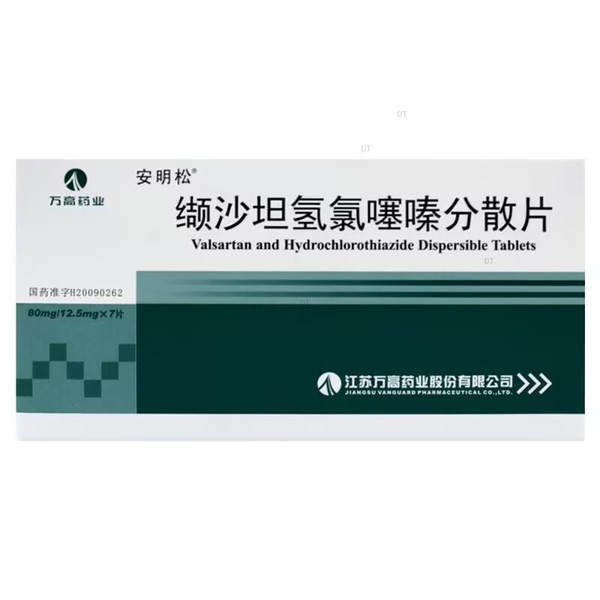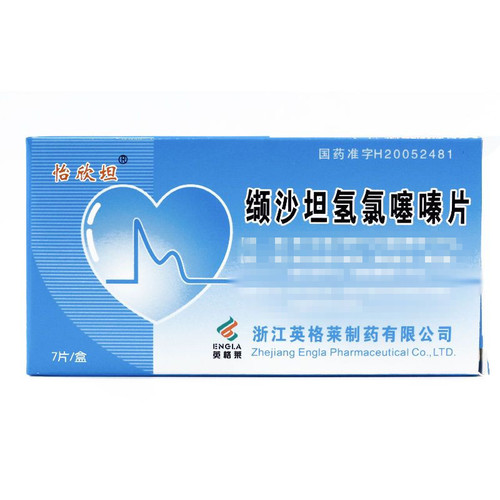Product Overview
[Drug Name]
Generic Name: Valsartan and Hydrochlorothiazide Dispersible Tablets
Trade Name: Anmingsong
English Name: Valsartan and Hydrochlorothiazide Dispersible Tablets
Chinese Pinyin: Jie Sha Tan Qing Lv Sai Qin Fen San Pian
[Ingredients]
This product is a combination preparation. Each tablet contains 80 mg of valsartan and 12.5 mg of hydrochlorothiazide.
[Appearance]
This product is a white or off-white tablet.
[Indications]
It is used to treat mild to moderate essential hypertension when blood pressure is not adequately controlled with a single medication. This product is not suitable for the initial treatment of hypertension.
[Dosage and Administration]
Each tablet contains 80 mg of valsartan and 12.5 mg of hydrochlorothiazide. It is used when blood pressure cannot be adequately controlled with valsartan alone. If blood pressure is not adequately controlled with hydrochlorothiazide 25 mg once daily or hypokalemia occurs, this product (combined with valsartan 80 mg/hydrochlorothiazide 12.5 mg) can be used as an alternative, one tablet once daily. Maximum antihypertensive effect is achieved within 2-4 weeks. No dose adjustment is required for patients with mild to moderate renal failure (creatinine clearance > 30 ml/min) or mild to moderate hepatic failure (non-biliary, non-cholestatic).
[Adverse Reactions]
The safety of this product has been evaluated in over 4,300 patients. Adverse reactions were generally mild and transient. Three controlled trials included a total of 7,616 patients. Adverse events reported in these trials are listed in the table below. Of these 7,616 patients, 4,372 received the combination of valsartan and hydrochlorothiazide. Adverse events occurring in less than 1% of patients included: abdominal pain, upper abdominal pain, anxiety, arthritis, asthenia, bronchitis, acute bronchitis, chest pain, positional dizziness, dyspepsia, dyspnea, dry mouth, erectile dysfunction, gastroenteritis, hyperhidrosis, decreased sensation, hypokalemia, hypotension, influenza, insomnia, muscle cramps, muscle tension, nausea, nasal congestion, neck pain, edema, peripheral edema, otitis media, pain in extremity, palpitations, paresthesia, sore throat, frequent urination, fever, rash, sinus congestion, sinusitis, somnolence, sprains and strains, tachycardia, tinnitus, urinary tract infection, vertigo, viral infection, blurred vision, and abnormal vision. It is not known whether these adverse events are treatment-related. Postmarketing data indicate that the following have been reported very rarely: angioedema, rash, pruritus, and other hypersensitivity/allergic reactions, including serum sickness and vasculitis. Very rare reports of impaired renal function and myalgia have been reported. Several cases of hydrochlorothiazide-induced pulmonary edema with granulocyte infiltration and IgG deposition in the alveolar membranes have been reported. Non-cardiogenic pulmonary edema may be a rare immune-mediated idiopathic reaction to hydrochlorothiazide.
[Contraindications]
Hypersensitivity to valsartan, hydrochlorothiazide, other sulfonamides, or any of the ingredients in this product. Pregnancy (see Pregnancy and Lactation). Severe hepatic impairment, biliary cirrhosis, or cholestasis. Severe renal failure (creatinine clearance <30 ml/min) or anuria. Refractory hypokalemia, hyponatremia, or hypercalcemia, and symptomatic hyperuricemia.
[Precautions]
Caution is advised regarding serum electrolyte changes with concomitant use of potassium-sparing diuretics, potassium supplements, potassium-containing salt substitutes, or other medications that increase potassium levels (e.g., heparin). Hypokalemia has been reported with thiazide diuretics; therefore, serum potassium levels should be monitored regularly. Thiazide diuretics, including hydrochlorothiazide, are associated with hyponatremia and hypochloremic alkalosis. Thiazides, including hydrochlorothiazide, can cause hypomagnesemia by increasing renal magnesium excretion. Sodium and/or volume depletion: Rarely, symptomatic hypotension may occur when initiating treatment with this drug in patients with severe sodium and/or volume depletion (e.g., high-dose diuretics). Hyponatremia and/or volume depletion should be corrected before initiating treatment with this drug. If hypotension occurs, the patient should be placed in the supine position and, if necessary, given normal saline. Treatment can be resumed after blood pressure stabilizes. Renal artery stenosis: There is no experience with the use of this drug in patients with unilateral or bilateral renal artery stenosis or solitary kidney stenosis. Renal impairment: No dose adjustment is required for patients with renal impairment and a creatinine clearance ≥30 ml/min. Hepatic impairment: No dose adjustment is required for patients with mild to moderate hepatic impairment that is not cholestatic, but this drug should be used with caution. Hepatic disease does not significantly affect the pharmacokinetics of hydrochlorothiazide. Systemic lupus erythematosus: Thiazide diuretics, including hydrochlorothiazide, have been reported to trigger or exacerbate systemic lupus erythematosus. Other metabolic disorders: Thiazide diuretics, including hydrochlorothiazide, can impair glucose tolerance and increase serum cholesterol, triglyceride, and uric acid levels. Effects on the ability to drive and operate machinery: As with other antihypertensive drugs, patients taking this medication should exercise caution when driving or operating machinery. Effects on athletes: This product contains hydrochlorothiazide. Thiazide diuretics can affect the metabolism and excretion of stimulants, potentially reducing the sensitivity of urine tests for stimulants. Therefore, athletes should use this product with caution. Please read the package insert carefully and use as directed by your doctor.
[Use in Special Populations]
Precautions for Pediatric Use:
Insufficient research data are available regarding the therapeutic use of this product in children.
Precautions for Pregnancy and Lactation:
Not yet available.
Precautions for Elderly:
Not yet available.
[Drug Interactions]
Drug interactions may occur if used concurrently with other medications. Consult your physician or pharmacist for details.
[Pharmacological Action] Not yet available.
[Storage] Store in a tightly closed container away from light.
[Specifications] Each tablet contains 80mg of valsartan and 12.5mg of hydrochlorothiazide.
[Packaging] Aluminum-plastic packaging, 80mg: 12.5mg x 7 tablets per box.
[Expiry Date] 24 months.
[Approval Number] National Medicine Standard H20090262.
[Manufacturer] Jiangsu Wangao Pharmaceutical Co., Ltd.






